|
Microsoft Developing SQL Databases (70-762) Exam Page2(Dumps)
Question No:-6
|
DRAG DROP -
Note: This question is part of a series of questions that use the same scenario. For your convenience, the scenario is repeated in each question. Each question presents a different goal and answer choices, but the text of the scenario is exactly the same in each question in the series.
You have a database named Sales that contains the following database tables. Customer, Order, and Products. The Products table and the order table shown in the following diagram.
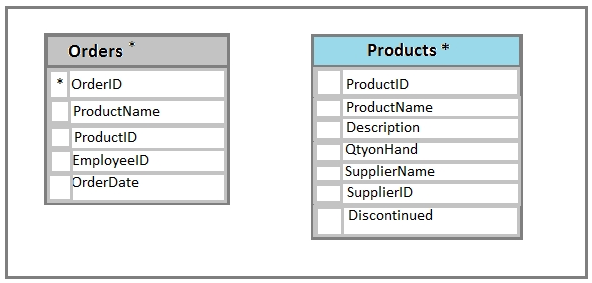
The Customer table includes a column that stores the date for the last order that the customer placed.
You plan to create a table named Leads. The Leads table is expected to contain approximately 20,000 records. Storage requirements for the Leads table must be minimized.
You need to begin to modify the table design to adhere to third normal form.
Which column should you remove for each table? To answer? drag the appropriate column names to the correct locations. Each column name may be used once, more than once, or not at all. You may need to drag the split bar between panes or scroll to view content.
Select and Place:
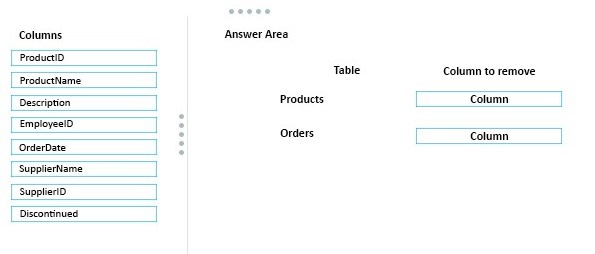
Answer:-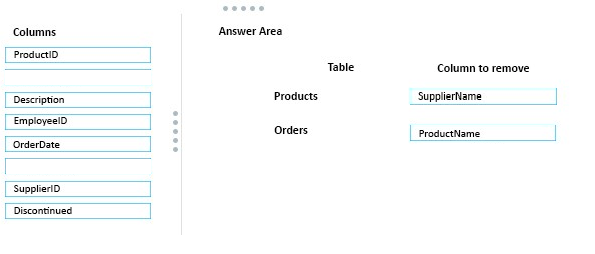
In the Products table the SupplierName is dependant on the SupplierID, not on the ProductID.
In the Orders table the ProductName is dependant on the ProductID, not on the OrderID.
Note:-
A table is in third normal form when the following conditions are met:
- It is in second normal form.
- All nonprimary fields are dependent on the primary key.
Second normal form states that it should meet all the rules for First 1Normnal Form and there must be no partial dependences of any of the columns onthe primary key.
First normal form (1NF) sets the very basic rules for an organized database:
- Define the data items required, because they become the columns in a table. Place related data items in a table.
- Ensure that there are no repeating groups ofdata.
- Ensure that there is a primary key.
Reference:-https://www.tutorialspoint.com/sql/third-normal-form.htm
|
|
Question No:-7
|
HOTSPOT -
Note: This question is part of a series of questions that use the same scenario. For your convenience, the scenario is repeated in each question. Each question presents a different goal and answer choices, but the text of the scenario is exactly the same in each question in this series.
You have a database that contains the following tables: BlogCategory, BlogEntry, ProductReview, Product, and SalesPerson. The tables were created using the following Transact SQL statements:
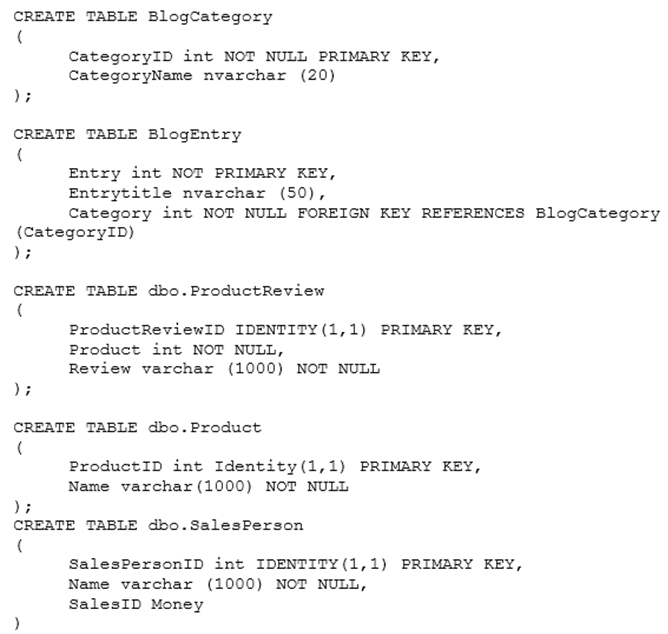
You must modify the ProductReview Table to meet the following requirements:
The table must reference the ProductID column in the Product table
- Existing records in the ProductReview table must not be validated with the Product table.
- Deleting records in the Product table must not be allowed if records are referenced by the ProductReview table.
- Changes to records in the Product table must propagate to the ProductReview table.
You also have the following database tables: Order, ProductTypes, and SalesHistory, The transact-SQL statements for these tables are not available.
You must modify the Orders table to meet the following requirements:
- Create new rows in the table without granting INSERT permissions to the table.
- Notify the sales person who places an order whether or not the order was completed.
You must add the following constraints to the SalesHistory table:
- a constraint on the SaleID column that allows the field to be used as a record identifier
- a constant that uses the ProductID column to reference the Product column of the ProductTypes table
- a constraint on the CategoryID column that allows one row with a null value in the column
- a constraint that limits the SalePrice column to values greater than four
Finance department users must be able to retrieve data from the SalesHistory table for sales persons where the value of the SalesYTD column is above a certain threshold.
You plan to create a memory-optimized table named SalesOrder. The table must meet the following requirements:
- The table must hold 10 million unique sales orders.
- The table must use checkpoints to minimize I/O operations and must not use transaction logging.
- Data loss is acceptable.
Performance for queries against the SalesOrder table that use Where clauses with exact equality operations must be optimized.
You need to enable referential integrity for the ProductReview table.
How should you complete the relevant Transact-SQL statement? To answer? select the appropriate Transact-SQL segments in the answer area.
Hot Area:
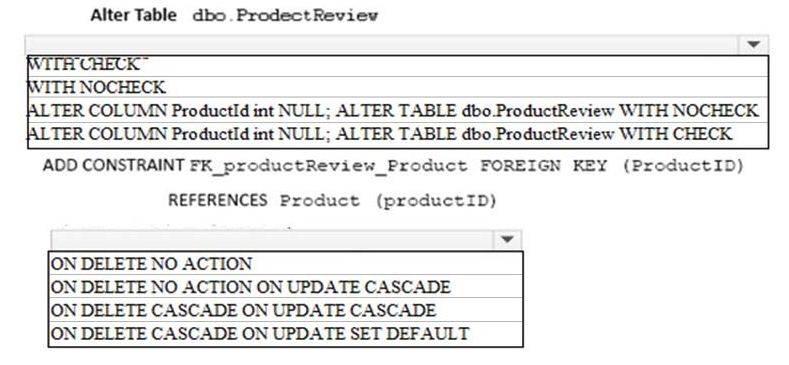
Answer:-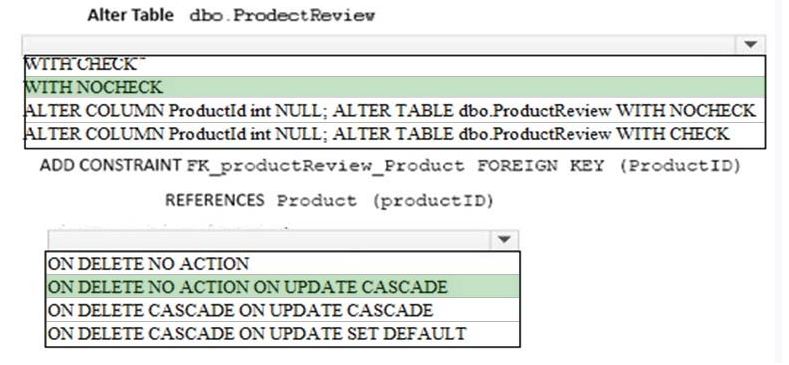
Box 1: WITH NOCHECK -
We should use WITH NOCHECK as existing records in the ProductReview table must not be validated with the Product table.
Box 2: ON DELETE NO ACTION ON DELETE NO CASCADE
Deletes should not be allowed, so we use ON DELETE NO ACTION.
Updates should be allowed, so we use ON DELETE NO CASCADE
NO ACTION: the Database Engine raises an error, and the update action on the row in the parent table is rolled back.
CASCADE: corresponding rows are updated in the referencing table when that row is updated in the parent table.
Note: ON DELETE { NO ACTION | CASCADE | SET NULL | SET DEFAULT }
Specifies what action happens to rows in the table that is altered, if those rows have a referential relationship and the referenced row is deleted from the parent table. The default is NO ACTION.
ON UPDATE { NO ACTION | CASCADE | SET NULL | SET DEFAULT }
Specifies what action happens to rows in the table altered when those rows have a referential relationship and the referenced row is updated in the parent table.
The default is NO ACTION.
Note: You must modify the ProductReview Table to meet the following requirements:
1. The table must reference the ProductID column in the Product table
2. Existing records in the ProductReview table must not be validated with the Product table.
3. Deleting records in the Product table must not be allowed if records are referenced by the ProductReview table.
4. Changes to records in the Product table must propagate to the ProductReview table.
Reference:-https://msdn.microsoft.com/en-us/library/ms190273.aspx
https://msdn.microsoft.com/en-us/library/ms188066.aspx
|
|
Question No:-8
|
HOTSPOT -
Note: This question is part of a series of questions that use the same scenario. For your convenience, the scenario is repeated in each question. Each question presents a different goal and answer choices, but the text of the scenario is exactly the same in each question in this series.
You have a database that contains the following tables: BlogCategory, BlogEntry, ProductReview, Product, and SalesPerson. The tables were created using the following Transact SQL statements:
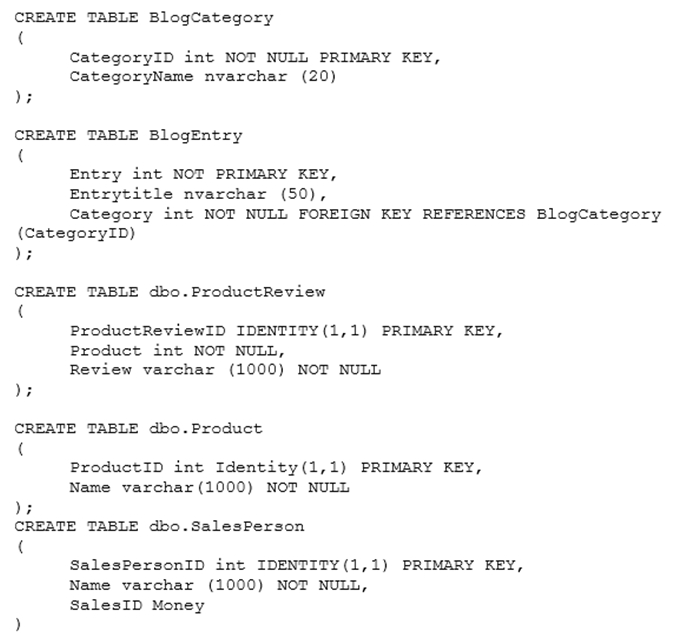
You must modify the ProductReview Table to meet the following requirements:
The table must reference the ProductID column in the Product table
- Existing records in the ProductReview table must not be validated with the Product table.
- Deleting records in the Product table must not be allowed if records are referenced by the ProductReview table.
- Changes to records in the Product table must propagate to the ProductReview table.
You also have the following database tables: Order, ProductTypes, and SalesHistory, The transact-SQL statements for these tables are not available.
You must modify the Orders table to meet the following requirements:
- Create new rows in the table without granting INSERT permissions to the table.
- Notify the sales person who places an order whether or not the order was completed.
You must add the following constraints to the SalesHistory table:
- a constraint on the SaleID column that allows the field to be used as a record identifier
- a constant that uses the ProductID column to reference the Product column of the ProductTypes table
- a constraint on the CategoryID column that allows one row with a null value in the column
- a constraint that limits the SalePrice column to values greater than four
Finance department users must be able to retrieve data from the SalesHistory table for sales persons where the value of the SalesYTD column is above a certain threshold.
You plan to create a memory-optimized table named SalesOrder. The table must meet the following requirements:
- The table must hold 10 million unique sales orders.
- The table must use checkpoints to minimize I/O operations and must not use transaction logging.
- Data loss is acceptable.
Performance for queries against the SalesOrder table that use Where clauses with exact equality operations must be optimized.
You need to create an object that allows finance users to be able to retrieve the required data. The object must not have a negative performance impact.
How should you complete the Transact-SQL statements? To answer, select the appropriate Transact-SQL segments in the answer area.
Hot Area:
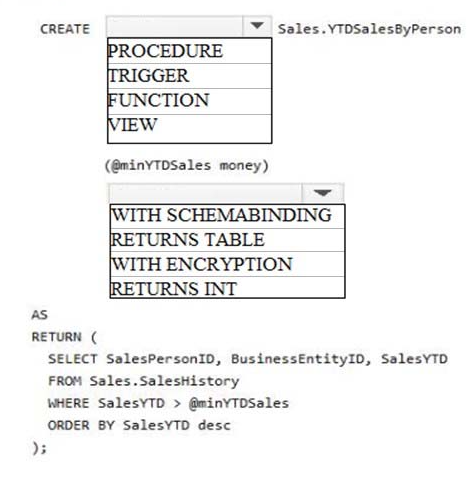
|
Question No:-9
|
Note: This question is part of a series of questions that use the same scenario. For your convenience, the scenario is repeated in each question. Each question presents a different goal and answer choices, but the text of the scenario is exactly the same in each question in this series.
You have a database that contains the following tables: BlogCategory, BlogEntry, ProductReview, Product, and SalesPerson. The tables were created using the following Transact SQL statements:
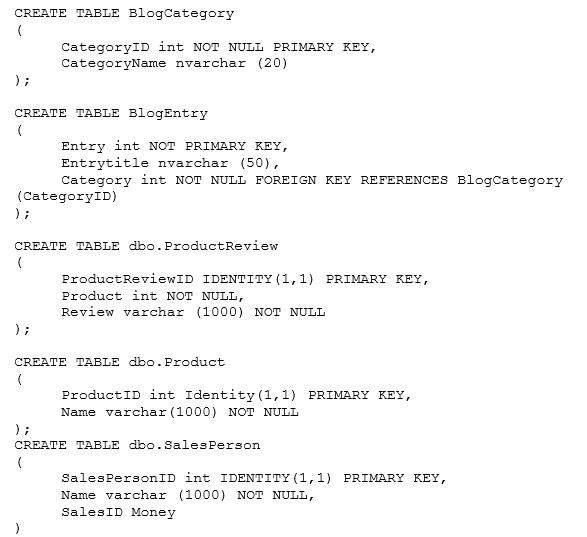
You must modify the ProductReview Table to meet the following requirements:
1. The table must reference the ProductID column in the Product table
2. Existing records in the ProductReview table must not be validated with the Product table.
3. Deleting records in the Product table must not be allowed if records are referenced by the ProductReview table.
4. Changes to records in the Product table must propagate to the ProductReview table.
You also have the following databse tables: Order, ProductTypes, and SalesHistory, The transact-SQL statements for these tables are not available.
You must modify the Orders table to meet the following requirements:
1. Create new rows in the table without granting INSERT permissions to the table.
2. Notify the sales person who places an order whether or not the order was completed.
You must add the following constraints to the SalesHistory table:
- a constraint on the SaleID column that allows the field to be used as a record identifier
- a constant that uses the ProductID column to reference the Product column of the ProductTypes table
- a constraint on the CategoryID column that allows one row with a null value in the column
- a constraint that limits the SalePrice column to values greater than four
Finance department users must be able to retrieve data from the SalesHistory table for sales persons where the value of the SalesYTD column is above a certain threshold.
You plan to create a memory-optimized table named SalesOrder. The table must meet the following requirments:
- The table must hold 10 million unique sales orders.
- The table must use checkpoints to minimize I/O operations and must not use transaction logging.
- Data loss is acceptable.
Performance for queries against the SalesOrder table that use Where clauses with exact equality operations must be optimized.
You need to modify the design of the Orders table.
What should you create?
A. a stored procedure with the RETURN statement
B. a FOR UPDATE trigger
C. an AFTER UPDATE trigger
D. a user defined function
Answer:-D. a user defined function
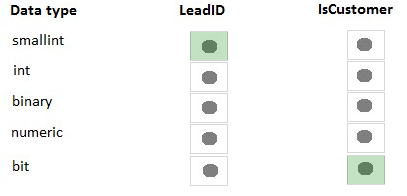 Note:-
Note:-
Requirements: You must modify the Orders table to meet the following requirements:
1. Create new rows in the table without granting INSERT permissions to the table.
2. Notify the sales person who places an order whether or not the order was completed.
Reference:-https://msdn.microsoft.com/en-us/library/ms186755.aspx
|
|
Question No:-10
|
HOTSPOT -
Note: This question is part of a series of questions that use the same scenario. For your convenience, the scenario is repeated in each question. Each question presents a different goal and answer choices, but the text of the scenario is exactly the same in each question in this series.
You have a database that contains the following tables: BlogCategory, BlogEntry, ProductReview, Product, and SalesPerson. The tables were created using the following Transact SQL statements:
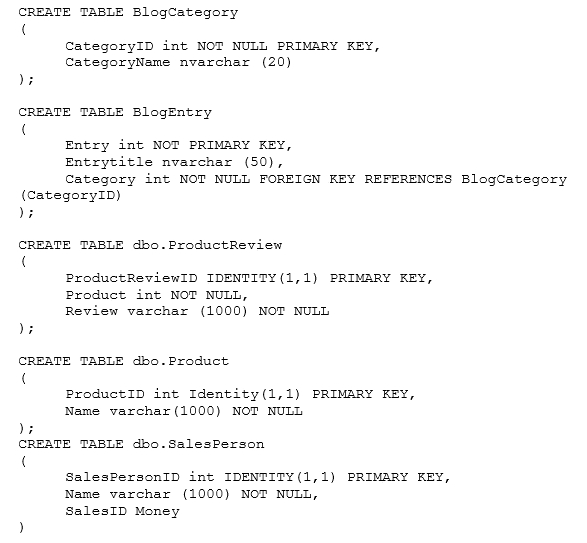
You must modify the ProductReview Table to meet the following requirements:
1. The table must reference the ProductID column in the Product table
2. Existing records in the ProductReview table must not be validated with the Product table.
3. Deleting records in the Product table must not be allowed if records are referenced by the ProductReview table.
4. Changes to records in the Product table must propagate to the ProductReview table.
You also have the following databse tables: Order, ProductTypes, and SalesHistory, The transact-SQL statements for these tables are not available.
You must modify the Orders table to meet the following requirements:
1. Create new rows in the table without granting INSERT permissions to the table.
2. Notify the sales person who places an order whether or not the order was completed.
You must add the following constraints to the SalesHistory table:
- a constraint on the SaleID column that allows the field to be used as a record identifier
- a constant that uses the ProductID column to reference the Product column of the ProductTypes table
- a constraint on the CategoryID column that allows one row with a null value in the column
- a constraint that limits the SalePrice column to values greater than four
Finance department users must be able to retrieve data from the SalesHistory table for sales persons where the value of the SalesYTD column is above a certain threshold.
You plan to create a memory-optimized table named SalesOrder. The table must meet the following requirments:
- The table must hold 10 million unique sales orders.
- The table must use checkpoints to minimize I/O operations and must not use transaction logging.
- Data loss is acceptable.
Performance for queries against the SalesOrder table that use Where clauses with exact equality operations must be optimized.
You need to update the SalesHistory table
How should you complete the Transact_SQL statement? To answer? select the appropriate Transact-SQL, segments in the answer area.
Hot Area:
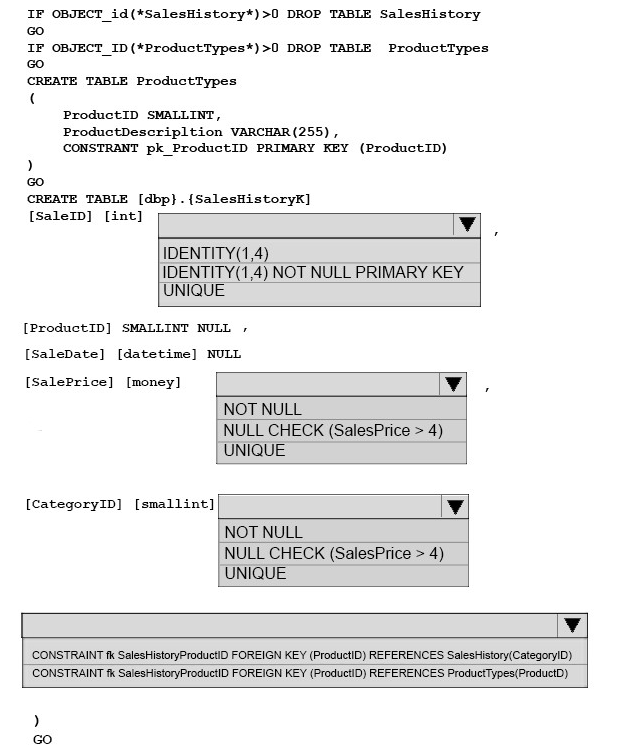
Answer:-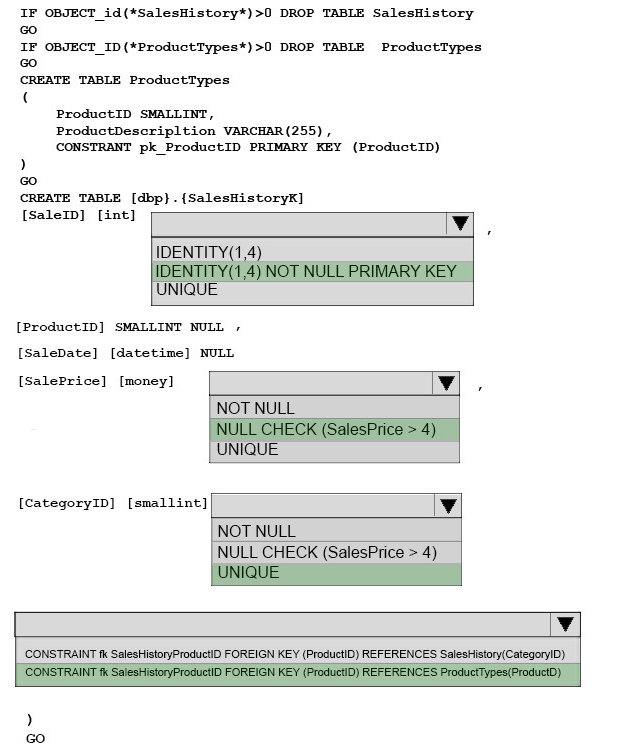 Note:-
Note:-
Box 1:
SaleID must be the primary key, as a constraint on the SaleID column that allows the field to be used as a record identifier is required.
Box 2:
A constraint that limits the SalePrice column to values greater than four.
Box 3: UNIQUE -
A constraint on the CategoryID column that allows one row with a null value in the column.
Box 4:
A foreign keyconstraint must be put on the productID referencing the ProductTypes table, as a constraint that uses the ProductID column to reference the Product column of the ProductTypes table is required.
Note: Requirements are:
You must add the following constraints to the SalesHistory table:
- a constraint on the SaleID column that allows the field to be used as a record identifier
- a constraint that uses the ProductID column to reference the Product column of the ProductTypes table
- a constraint on the CategoryID column that allows one row with a null value in the column
- a constraint that limits the SalePrice column to values greater than four
|
|
|